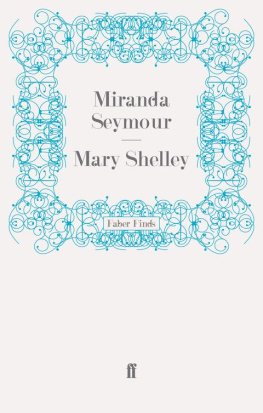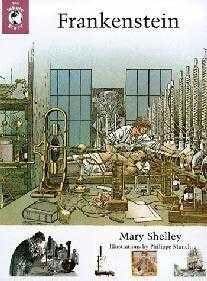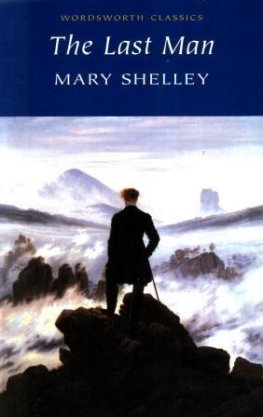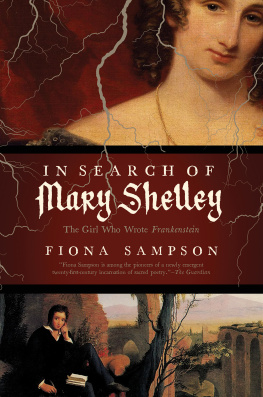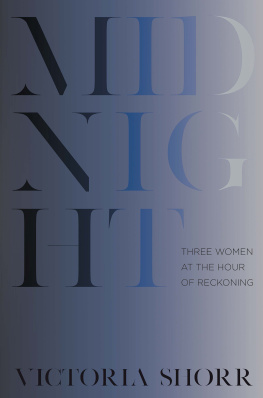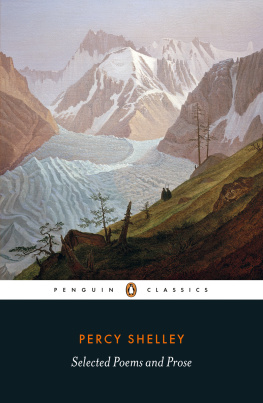Seymour Miranda - Mary Shelley
Here you can read online Seymour Miranda - Mary Shelley full text of the book (entire story) in english for free. Download pdf and epub, get meaning, cover and reviews about this ebook. City: England, year: 2011, publisher: Faber & Faber, genre: Detective and thriller. Description of the work, (preface) as well as reviews are available. Best literature library LitArk.com created for fans of good reading and offers a wide selection of genres:
Romance novel
Science fiction
Adventure
Detective
Science
History
Home and family
Prose
Art
Politics
Computer
Non-fiction
Religion
Business
Children
Humor
Choose a favorite category and find really read worthwhile books. Enjoy immersion in the world of imagination, feel the emotions of the characters or learn something new for yourself, make an fascinating discovery.
- Book:Mary Shelley
- Author:
- Publisher:Faber & Faber
- Genre:
- Year:2011
- City:England
- Rating:4 / 5
- Favourites:Add to favourites
- Your mark:
- 80
- 1
- 2
- 3
- 4
- 5
Mary Shelley: summary, description and annotation
We offer to read an annotation, description, summary or preface (depends on what the author of the book "Mary Shelley" wrote himself). If you haven't found the necessary information about the book — write in the comments, we will try to find it.
Mary Shelley — read online for free the complete book (whole text) full work
Below is the text of the book, divided by pages. System saving the place of the last page read, allows you to conveniently read the book "Mary Shelley" online for free, without having to search again every time where you left off. Put a bookmark, and you can go to the page where you finished reading at any time.
Font size:
Interval:
Bookmark:
The sleep of reason produces monsters.
Goya, LosCaprichos (1799)
Appendices
Mary Shelleys course was set from that early morning in the summer of 1814 when she and her stepsister Claire Clairmont left their home in dingy Holborn to run away with Percy Shelley across war-ravaged France to Switzerland, seen by them as the romantic birthplace of the Enlightenment. Mary was only sixteen, her stepsister was fifteen. Shelley, just twenty-one, had left his young pregnant wife behind. The following spring, Mary gave birth to his child, a little girl who died a few weeks later.
Eight years on, Mary miscarried her fifth child. Only one survived. She was not yet twenty-five when Shelley drowned in a sailing accident with a friend off the north-west coast of Italy. Shelleys death was the scene to which Victorian painters were drawn, and one can see why. His friends Edward Trelawny, Byron and Leigh Hunt were there to see the fish-eaten remains of the poets body burned on a lonely shore while Mary, shocked and grief-stricken, shut herself away in her room to mourn alone. After her death, a sculptor would show her as the materdolorosa, her husbands body stretched over her knees.
Today, the most famous scene from Marys life and, perhaps, in literary history is the stormy summer night at the Villa Diodati on Lake Geneva when Byron, his handsome young doctor John Polidori, the Shelleys and Marys stepsister, who was carrying Byrons child, decided to write horror stories for fun. This was the night on which Frankenstein, that best known of all Romantic works, was born. Its author was not yet nineteen.
Frankenstein has become part of our lives. The ambitious young scientist who, in Marys bold imagination, became the first creator of a living human being without divine assistance a shocking idea in her day and an extraordinary one for a young woman to choose for her first subject is invoked almost daily in debates on the ethics of genetic engineering. Cartoonists from George Cruikshank to Gary Larsen have made use of Frankenstein; a recent survey among American children showed his name to be more familiar than that of the President.
Many books have been written about Frankenstein. The subject is of endless fascination. Where did the idea come from? Why did Mary choose to make the Creature a monster? Was she, as as some have suggested , exorcizing her own demons? Mary Wollstonecraft died a few days after giving birth to Mary; did Mary see herself as the monstrous child who killed her mother, or does the Creature represent her tormented relationship with Mary Jane Clairmont, the stepmother who made her feel an exile in her own home?
In the course of research, new possibilities presented themselves. As a sickly and troubled young girl, Mary was sent away from her family to live among strangers at Dundee, then one of the biggest whaling ports in Britain. The story which encloses the tale of Victor Frankenstein and his scientific experiment is of an ambitious young man who sets off to find a new land beyond the North Pole, following the route taken by the whaling vessels which were a feature of Marys life at Dundee. It was there, she wrote later, that my true compositions , the airy flights of my imagination, were born and fostered. Here, it appears, she began work on a story which was later adapted to frame the story of Frankenstein.
A further and intriguing possibility emerged as I was considering the summer of 1815, when Mary was temporarily on her own, staying in lodgings at Clifton. Living within strolling distance of Bristol, a town which had grown prosperous on the slave trade, Mary read books on the subject with increasing horror and indignation. Slavery, although formally abolished in England, remained a thriving industry ; in England, slaves were still being rescued from service in the mid-nineteenth century. At Bristol, the evidence was all around her. Here, surely, was the explanation for the Creatures carefully described and decidedly un-English appearance, his hair of a lustrous blackness , his yellow skin and teeth of a pearly whiteness, features which, when combined with his strength and muscular build, suggest that the author was deliberately evoking the African and West Indian, while his yellow skin hints at the Eastern lascars whom she would have seen on her journeys from the London docks. Here, too, was a clue to why Mary, whose sympathies as an author are with the Creature, lays so much emphasis on the fact that Victor Frankenstein judges him misjudges him by his appearance. She was, it seems, covertly attacking a society which still believed that the physical appearance of the Africans indicated their moral inferiority to Europeans.
My interest in Mary began with the woman, not the subject. Twenty-five years ago I wrote a historical novel about Byron. This led me to the Shelleys. Richard Holmess enthralling life of the poet had just been published; there, I encountered Mary as a sulky, bad- tempered young woman, a nagging wife. Edward Trelawnys celebrated memoirs confirmed Holmess portrait while suggesting also that Mary was a relentless social climber, frantic to be accepted on any terms. Why, I wondered, should Shelley have left his pretty young first wife and risked disgrace for such a woman? If he did have an affair with Marys stepsister, well, why not? They lived in the same house; they all believed in free love; Claire Clairmont sounded amusing and attractive. If Mary spent her widowhood struggling to promote her husbands reputation and to elevate him to the status of a saint, she was no doubt compensating for having failed him during his life. This, I am embarrassed to remember, was how I presented Mary in my novel. I thought it was the truth.
Biographers are often drawn to a subject with whom they have made some form of identification. Living on my own in London and bringing up a young son on not very much money, I began to think about Mary again. She, after Shelleys death, was forced to bring her little boy back to England from Italy, the land she loved, in order to obtain an allowance she had no money of her own and Shelleys will had been lost from her disapproving father-in-law, Sir Timothy Shelley. Her own father, William Godwin, once highly regarded as the author of one of the boldest works of the late eighteenth century, AnEnquiryconcerningPoliticalJustice, was by 1823 destitute and dependent on Marys help for his own survival.
Despite Sir Timothys grudging payments, all of which were expected to be returned to the estate, with interest, after his death, and his insistence that she should neither publish his sons works nor use his name, Mary managed to write successfully enough to keep them all. At the same time, although she was herself treated as a social outcast, she risked her reputation to help her friends. I have ever defended women when oppressed, she wrote in the journal to which she confided her most private thoughts. When one friend was exiled from her husbands house because she had been having an affair, Mary unhesitatingly championed and cared for her; when another had an illegitimate child, Mary helped mastermind a daring plan to send her abroad on a forged passport as the wife of a woman who had boldly decided to become a transvestite. This, I began to realize, was a woman of exceptional courage and determination. She had no need to reproach herself for not having, like her mother, written AVindicationoftheRightsofWoman; she was a heroine in her own right.
The more I read, the more Mary intrigued me. Not only did she live in a period of radical social transition, commencing in the bitter aftermath of the French Revolution and ending in the age of commerce she died in 1851, the year of the Great Exhibition but in what a circle! Not only Coleridge, Byron, Scott, Trelawny, but Melbourne, Disraeli, Lady Blessington and Caroline Norton Mary had known them all. Outcast though she felt herself to be, her friends had included the most fascinating and influential people of her times. It seemed a cruel irony that Sir Timothy Shelley, a wealthy provincial landowner whose world was circumscribed by the borders of his Sussex estate and who, it happens, was in no position to sit in judgment on the behaviour of his sons young widow, should have possessed the power to control and restrict the life of a woman far superior to himself.
Font size:
Interval:
Bookmark:
Similar books «Mary Shelley»
Look at similar books to Mary Shelley. We have selected literature similar in name and meaning in the hope of providing readers with more options to find new, interesting, not yet read works.
Discussion, reviews of the book Mary Shelley and just readers' own opinions. Leave your comments, write what you think about the work, its meaning or the main characters. Specify what exactly you liked and what you didn't like, and why you think so.

